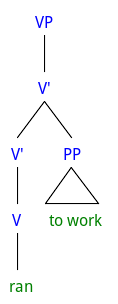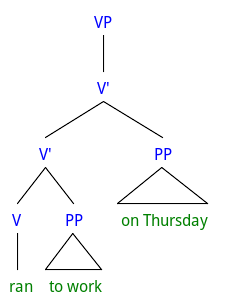How will a Do-So test help in identifying if a PP is an adjunct or complement to the verb? Example : I ran to work. I need two pieces of evidence to prove the status of PP in a sentence.
1 Answer
Recall that in English, adjunction is believed to look like this:

If the lower V' is a constituent, then we should expect it to be substitutable by 'do so' in the standard test, but we can't say that:
#I did so to work. (meaning 'I ran to work')
By contrast, you can substitute the whole thing 'ran to work' with do-so:
I went to work on Thursday.
I did so on Thursday.
This suggests that 'on Thursday' is an adjunct and 'to work' is the complement, i.e. this structure is appropriate:
-
Caution: Identification of adverbial phrases is ambiguous (unless marked by a comma). I ran, [in order] to work [out]. I worked on Thursday['s edition of the newspaper].– amICommented Mar 29, 2017 at 21:39
-
@amI But if the meaning's evident then the structure is not ambiguous. Commented Mar 29, 2017 at 22:49
-
Many grammarians use "licensing" to determine whether an element is a complement or an adjunct/modifier. Essentially, an element has to be "licensed" by an appropriate head to qualify as a complement.– BillJCommented Mar 31, 2017 at 7:15
-
@BillJ I agree that's a useful test, but the OP asked for do-so, so I... lowers glasses did so. Commented Mar 31, 2017 at 15:34
-
The 'do-so' test merely shifts the tense to an auxiliary and replaces the verb with a pronoun (so, it, that, ...). It is only good for identifying the direct object, since we only expect un-case-marked objects after an actual verb. Thus 'I ate the cake' becomes 'I did so to the cake'. "I did so to work" is not ungrammatical; it is merely clunky because 'to' is poly-semantic.– amICommented Apr 6, 2017 at 20:44
